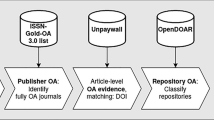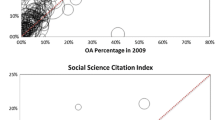Abstract
This study investigated the longitudinal impact of Open-Access (OA) publication in Israel, a country which has not yet adopted a formal OA policy. We analyzed bibliometric indicators of Israeli researchers across all academic disciplines, focusing on OA publications published in journals and repositories from 2010 to 2020. Data extracted from Scopus reveal a consistent “OA citation advantage” (OACA) throughout the study period, suggesting the influence of OA publication on citation rates beyond time and scientific novelty. Despite the highest number of publications in the green route, steadily increasing over the years, and a recent rise in gold route publications, the hybrid route demonstrates a significantly higher citation advantage, highlighting an “OA subtype citation effect”. Furthermore, our study uncovers a “funding effect” on OA grant-funded publications, indicating a doubled likelihood of publishing in OA when research is funded, contingent on the funder’s OA policy. The findings offer comprehensive insights into OA publishing trends in Israel, serving as a case study for assessing the impact of OA policy. The study underscores the importance of both funder-specific OA policies and broader initiatives by the global scientific community and intergovernmental organizations to promote OA publishing and address potential disparities in research dissemination. Efforts to combat the “rich get richer” effect can foster equitable access to scientific knowledge.








Similar content being viewed by others
References
Andreoli-Versbach, P., & Mueller-Langer, F. (2014). Open access to data: An ideal professed but not practiced. Research Policy, 43(9), 1621–1633.
Archambault, É., Amyot, D., Deschamps, P., Nicol, A., Provencher, F., Rebout, L., & Roberge, G. (2014). Proportion of open access papers published in peer-reviewed journals at the European and world levels 1996–2013. Libraries at University of Nebraska-Lincoln. https://digitalcommons.unl.edu/scholcom/8/
Baas, J., Schotten, M., Plume, A., Côté, G., & Karimi, R. (2020). Scopus as a curated, high-quality bibliometric data source for academic research in quantitative science studies. Quantitative Science Studies, 1(1), 377–386.
Bakhmat, N., Kolosiva, O., Demchenko, O., Ivashchenko, I., & Strelchuk, V. I. K. T. O. R. I. A. (2022). Application of international scientometric databases in the process of training competitive research and teaching staff: Opportunities of Web of Science (WoS), Scopus, Google Scholar. Journal of Theoretical and Applied Information Technology, 100(13), 4914–4924.
Beall, J. (2015). What the open-access movement doesn’t want you to now. Academe, 101(3), 37–40.
Björk, B. C. (2017). Growth of hybrid open access, 2009–2016. PeerJ, 5, e3878.
Blankstein, M., & Wolff-Eisenberg, C. (2019). Ithaka S+ R US Faculty Survey 2018. Ithaka S+ R. https://doi.org/10.18665/sr.311199
Bornmann, L., & Marx, W. (2014). How to evaluate individual researchers working in the natural and life sciences meaningfully? A proposal of methods based on percentiles of citations. Scientometrics, 98, 487–509.
Bosman, J., & Kramer, B. (2018). Open access levels: A quantitative exploration using web of science and Oa data. PeerJ, 6, e3520v1. https://doi.org/10.7287/peerj.preprints.3520v1
Clayson, P. E., Baldwin, S. A., & Larson, M. J. (2021). The open access advantage for studies of human electrophysiology: Impact on citations and altmetrics. International Journal of Psychophysiology, 164, 103–111.
Colavizza, G., Hrynaszkiewicz, I., Staden, I., Whitaker, K., & McGillivray, B. (2020). The citation advantage of linking publications to research data. PLoS ONE, 15(4), e0230416.
Craig, I. D., Plume, A. M., McVeigh, M. E., Pringle, J., & Amin, M. (2007). Do open access articles have greater citation impact?: A critical review of the literature. Journal of Informetrics, 1(3), 239–248.
Delgado López-Cózar, E., Orduña-Malea, E., & Martín-Martín, A. (2019). Google Scholar as a data source for research assessment. In Springer handbook of science and technology indicators (pp. 95–127). Springer.
Edwards, A. (2016). Perspective: Science is still too closed. Nature, 533(7602), S70–S70. https://doi.org/10.1038/533S70a
Elliott, L. (September, 2020). Israel Science Foundation leads the way in open science with the launch of dedicated open access publishing gateway. F1000Research Blognetwork. https://tinyurl.com/mw4xnrjd
European Open Science Cloud. (2022). Policy. EU member states: Israel. European Open Science Cloud. https://eosc-portal.eu/israel
Gargouri, Y., Hajjem, C., Larivière, V., Gingras, Y., Carr, L., Brody, T., & Harnad, S. (2010). Self-selected or mandated, open access increases citation impact for higher quality research. PLoS ONE, 5(10), e13636.
Gasparyan, A. Y., Yessirkepov, M., Voronov, A. A., Koroleva, A. M., & Kitas, G. D. (2019). Comprehensive approach to open access publishing: Platforms and tools. Journal of Korean Medical Science, 34(27), e217.
Hadad, S., & Aharony, N. (2022). Factors influencing researchers to publish in open-access: Is it a self-decision or a self-reinforcing cycle? Online Information Review. https://doi.org/10.1108/OIR-01-2022-0014
Hadad, S., & Aharony, N. (2023a). Open access advantages as a function of the discipline: Mixed-methods study. The Journal of Academic Librarianship, 49(4), 102746.
Hadad, S., & Aharony, N. (2023b). Researchers’ perceptions, patterns, motives, and challenges in self-archiving as a function of the discipline. Journal of Librarianship and Information Science, 09610006221146768.
Halevi, G., & Walsh, S. (2021). Faculty attitudes towards article processing charges for open access articles. Publishing Research Quarterly, 37(3), 384–398.
Harzing, A. W., & Alakangas, S. (2016). Google Scholar, Scopus and the Web of Science: A longitudinal and cross-disciplinary comparison. Scientometrics, 106(2), 787–804.
Iyandemye, J., & Thomas, M. P. (2019). Low income countries have the highest percentages of open access publication: A systematic computational analysis of biomedical literature. PLoS ONE, 14(7), e0220229. https://doi.org/10.1371/journal.pone.0220229
Laakso, M. (2014). Green open access policies of scholarly journal publishers: A study of what, when, and where self-archiving is allowed. Scientometrics, 99(2), 475–494. https://doi.org/10.1007/s11192-013-1205-3
Laakso, M., & Björk, B. C. (2016). Hybrid open access—A longitudinal study. Journal of Informetrics, 10(4), 919–932.
Laakso, M., Welling, P., Bukvova, H., Nyman, L., Björk, B. C., & Hedlund, T. (2011). The development of open access journal publishing from 1993 to 2009. PLoS ONE, 6(6), e20961. https://doi.org/10.1371/journal.pone.0020961
Langham-Putrow, A., Bakker, C., & Riegelman, A. (2021). Is the open access citation advantage real? A systematic review of the citation of open access and subscription-based articles. PLoS ONE, 16(6), e0253129.
Lee, J. J., & Haupt, J. P. (2021). Scientific globalism during a global crisis: Research collaboration and open access publications on COVID-19. Higher Education, 81(5), 949–966.
Maddi, A. (2019). Construction of a normalized open access indicator (NOAI). Hal-02328158. https://cepn.univ-paris13.fr/wp-content/uploads/2019/10/DT-CEPN-2019-08.pdf
Martín-Martín, A., Costas, R., van Leeuwen, T., & López-Cózar, E. D. (2018). Evidence of open access of scientific publications in Google Scholar: A large-scale analysis. Journal of Informetrics, 12(3), 819–841.
McCullough, R. (2022, January 13). Scopus filters for Open Access type and Green OA full-text access option. Scopus. https://blog.scopus.com/posts/scopus-filters-for-open-access-type-and-green-oa-full-text-access-option
Morillo, F. (2020). Is open access publication useful for all research fields? Presence of funding, collaboration and impact. Scientometrics, 125(1), 689–716.
Moskovkin, V. M., Saprykina, T. V., Sadovski, M. V., & Serkina, O. V. (2021). International movement of open access to scientific knowledge: A quantitative analysis of country involvement. The Journal of Academic Librarianship, 47(1), 102296. https://doi.org/10.1016/j.acalib.2020.102296
Mueller-Langer, F., Scheufen, M., & Waelbroeck, P. (2020). Does online access promote research in developing countries? Empirical evidence from article-level data. Research Policy, 49(2), 103886.
Mueller-Langer, F., & Watt, R. (2014). The hybrid open access citation advantage: How many more cites is a $3,000 fee buying you?. Published as How Many More Cites is a $3,000 Open Access Fee Buying You, 931–954.
Natale, E. (2019). In Open Access’s Long Shadow—A view from the Humanities. Journal for Library Culture, 6(1), 25–47.
Olejniczak, A. J., & Wilson, M. J. (2020). Who’s writing open access (OA) articles? Characteristics of OA authors at Ph.D.-granting institutions in the United States. Quantitative Science Studies, 1(4), 1429–1450.
Ottaviani, J. (2016). The post-embargo open access citation advantage: It exists (probably), its modest (usually), and the rich get richer (of course). PLoS ONE, 11(8), e0159614. https://doi.org/10.1371/journal.pone.0159614
Paul-Hus, A., Díaz-Faes, A. A., Sainte-Marie, M., Desrochers, N., Costas, R., & Larivière, V. (2017). Beyond funding: Acknowledgement patterns in biomedical, natural and social sciences. PLoS ONE, 12(10), e0185578.
Pinfield, S., Wakeling, S., Bawden, D., & Robinson, L. (2020). Open access in theory and practice: The theory-practice relationship and openness (1st ed.). Routledge. https://doi.org/10.4324/9780429276842
Pislyakov, V. (2022). On some properties of medians, percentiles, baselines, and thresholds in empirical bibliometric analysis. Journal of Informetrics, 16(4), 101322. https://doi.org/10.1016/j.joi.2022.101322
Piwowar, H., Priem, J., Larivière, V., Alperin, J. P., Matthias, L., Norlander, B., Farley, A., West, J., & Haustein, S. (2018). The state of OA: A large-scale analysis of the prevalence and impact of Open Access articles. PeerJ, 6, e4375.
Ploder, M., Glänzel, W., Meier, A., Sauer, A., Dvorzak, M., Thijs, B., & Rosenberger, S. (2020). DFG Funding Programme Open Access Publishing-Report about the Funding (No. FZJ-2022-01294). Zentralbibliothek.
Pollock, D., & Michael, A. (2019). Open access myth busting: Testing two prevailing assumptions about the effects of open access adoption. Learned Publishing, 32(1), 7–12. https://doi.org/10.1002/leap.1209
Pranckutė, R. (2021). Web of Science (WoS) and scopus: The Titans of bibliographic information in today’s academic world. Publications, 9(1), 12. https://doi.org/10.3390/publications9010012
Sanjeeva, M., & Powdwal, S. (2017). Open access initiatives: Reframing the role of librarians. Library Herald, 55(4), 467–487.
Shen, C., & Björk, B. C. (2015). ‘Predatory’ open access: A longitudinal study of article volumes and market characteristics. BMC Medicine, 13(1), 230.
Solomon, D. J., & Björk, B. C. (2012). A study of open access journals using article processing charges. Journal of the American Society for Information Science and Technology, 63(8), 1485–1495.
Tahamtan, I., Safipour Afshar, A., & Ahamdzadeh, K. (2016). Factors affecting number of citations: A comprehensive review of the literature. Scientometrics, 107(3), 1195–1225.
Tennant, J. P., Crane, H., Crick, T., Davila, J., Enkhbayar, A., Havemann, J., Kramer, B., Martin, R., Masuzzo, P., Nobes, A., Rice, C., Rivera-López, B., Ross-Hellauer, T., Sattler, S., Thacker, P. D., & Vanholsbeeck, M. (2019). Ten hot topics around scholarly publishing. Publications, 7(2), 34. https://doi.org/10.3390/publications7020034
Tennant, J. P., Waldner, F., Jacques, D. C., Masuzzo, P., Collister, L. B., & Hartgerink, C. H. (2016). The academic, economic and societal impacts of Open Access: An evidence-based review. F1000Research, 5, 632. https://doi.org/10.12688/f1000research.8460.3
Tokmachev, A. M. (2023). Hidden scales in statistics of citation indicators. Journal of Informetrics, 17(1), 101356. https://doi.org/10.1016/j.joi.2022.101356
Valderrama-Zurián, J. C., Aguilar-Moya, R., & Gorraiz, J. (2019). On the bibliometric nature of a foreseeable relationship: Open access and education. Scientometrics, 120(3), 1031–1057.
Velterop, J. (2003). Should scholarly societies embrace Open Access (or is it the kiss of death)? Learned Publishing, 16(3), 167–169.
Wang, L. L., Lo, K., Chandrasekhar, Y., Reas, R., Yang, J., Eide, D., & Kohlmeier, S. (2020). Cord-19: The covid-19 open research dataset. Retrieved May 24, 2022, from, https://arxiv.org/abs/2004.10706
White, R. K., Angelo, A., Fitchett, D., Fraser, M., Hayes, L., Howie, J., & White, B. (2021). Only two out of five articles by New Zealand researchers are free-to-access: A multiple API study of access, citations, cost of Article Processing Charges (APC), and the potential to increase the proportion of open access. PeerJ, 9, e11417.
Young, J. S., & Brandes, P. M. (2020). Green and gold open access citation and interdisciplinary advantage: A bibliometric study of two science journals. The Journal of Academic Librarianship, 46(2), 102–105.
Zhu, Y. (2017). Who support open access publishing? Gender, discipline, seniority and other factors associated with academics’ OA practice. Scientometrics, 111(2), 557–579.
Zia, S. (2021). An analysis of research output in open access journals in BRICS countries: A bibliometric study. Global Knowledge, Memory and Communication. https://doi.org/10.1108/GKMC-08-2020-0109
Acknowledgements
This work was supported by the Department of Information Science and the Faculty of Humanities at Bar-Ilan University.
Funding
The study was funded by the Faculty of Humanities and the Department of Information Sciences, Bar Ilan University.
Author information
Authors and Affiliations
Contributions
SH: Conceptualization, Investigation, Methodology, Formal analysis, Visualization, Writing- Original draft preparation. NA: Conceptualization; Writing—Review & Editing, Supervision. DRR: Conceptualization; Writing—Review & Editing, Supervision.
Corresponding author
Rights and permissions
Springer Nature or its licensor (e.g. a society or other partner) holds exclusive rights to this article under a publishing agreement with the author(s) or other rightsholder(s); author self-archiving of the accepted manuscript version of this article is solely governed by the terms of such publishing agreement and applicable law.
About this article
Cite this article
Hadad, S., Aharony, N. & Raban, D.R. Policy shaping the impact of open-access publications: a longitudinal assessment. Scientometrics 129, 237–260 (2024). https://doi.org/10.1007/s11192-023-04875-3
Received:
Accepted:
Published:
Issue Date:
DOI: https://doi.org/10.1007/s11192-023-04875-3




